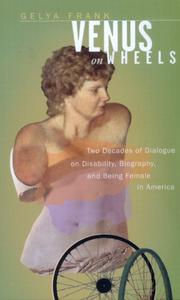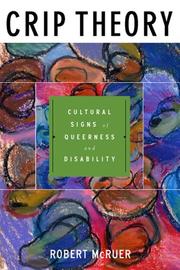| Listing 1 - 2 of 2 |
Sort by
|

ISBN: 0520922352 1597349763 9780520922358 0585391785 9780585391786 9780520217157 0520217152 9780520217164 0520217160 9781597349765 0520217152 0520217160 Year: 2000 Publisher: Berkeley, Calif. University of California Press
Abstract | Keywords | Export | Availability | Bookmark
 Loading...
Loading...Choose an application
- Reference Manager
- EndNote
- RefWorks (Direct export to RefWorks)
In 1976 Gelya Frank began writing about the life of Diane DeVries, a woman born with all the physical and mental equipment she would need to live in our society--except arms and legs. Frank was 28 years old, DeVries 26. This remarkable book--by turns moving, funny, and revelatory--records the relationship that developed between the women over the next twenty years.
DeVries, Diane. --- Women with disabilities - United States - Biography. --- Discrimination against people with disabilities --- People with disabilities --- Sociology of disability --- Women with disabilities --- #SBIB:316.346H29 --- #SBIB:39A9 --- Handicapped women --- Physically handicapped women --- Cripples --- Disabled --- Disabled people --- Disabled persons --- Handicapped --- Handicapped people --- Individuals with disabilities --- People with physical disabilities --- Persons with disabilities --- Physically challenged people --- Physically disabled people --- Physically handicapped --- Persons --- Disabilities --- Sociology of disablement --- Sociology of impairment --- Psychology --- Social conditions --- Positie van de vrouw in de samenleving: andere topics --- Medische antropologie / gezondheid / handicaps --- Sociological aspects --- Sociology of minorities --- United States --- United States of America --- Disability --- Biography --- Book --- Discrimination --- Social conditions. --- Psychology.

ISBN: 081475712X 0814757138 9780814757130 9780814757123 0814759866 0814761097 1435600398 Year: 2006 Publisher: New York, N.Y. New York University Press
Abstract | Keywords | Export | Availability | Bookmark
 Loading...
Loading...Choose an application
- Reference Manager
- EndNote
- RefWorks (Direct export to RefWorks)
Crip Theory attends to the contemporary cultures of disability and queerness that are coming out all over. Both disability studies and queer theory are centrally concerned with how bodies, pleasures, and identities are represented as “normal” or as abject, but Crip Theory is the first book to analyze thoroughly the ways in which these interdisciplinary fields inform each other.Drawing on feminist theory, African American and Latino/a cultural theories, composition studies, film and television studies, and theories of globalization and counter-globalization, Robert McRuer articulates the central concerns of crip theory and considers how such a critical perspective might impact cultural and historical inquiry in the humanities. Crip Theory puts forward readings of the Sharon Kowalski story, the performance art of Bob Flanagan, and the journals of Gary Fisher, as well as critiques of the domesticated queerness and disability marketed by the Millennium March, or Bravo TV’s Queer Eye for the Straight Guy. McRuer examines how dominant and marginal bodily and sexual identities are composed, and considers the vibrant ways that disability and queerness unsettle and re-write those identities in order to insist that another world is possible.
Culture. --- Heterosexuality -- Social aspects. --- Homosexuality -- Social aspects. --- Marginality, Social. --- Queer theory. --- Sociology of disability. --- Sociology of disability --- Homosexuality --- Heterosexuality --- Marginality, Social --- Culture --- Queer theory --- Social Welfare & Social Work --- Social Sciences --- Disabilities --- Social aspects --- 82:3 --- 82:316 --- 82:159.9 --- Literatuur en maatschappijwetenschappen --- Literatuursociologie --- Literatuur en psychologie. Literatuur en psychoanalyse --- Social aspects. --- 82:159.9 Literatuur en psychologie. Literatuur en psychoanalyse --- 82:316 Literatuursociologie --- 82:3 Literatuur en maatschappijwetenschappen --- Sociology of the family. Sociology of sexuality --- Sociology of culture --- Sociology of disablement --- Sociology of impairment --- People with disabilities --- Gender identity --- Exclusion, Social --- Marginal peoples --- Social exclusion --- Social marginality --- Assimilation (Sociology) --- Culture conflict --- Social isolation --- Sociology --- People with social disabilities --- Sexual orientation --- Cultural sociology --- Civilization --- Popular culture --- Sociological aspects --- Mental health --- Queer --- Body --- Physical health --- Theory --- Book
| Listing 1 - 2 of 2 |
Sort by
|

 Search
Search Feedback
Feedback About UniCat
About UniCat  Help
Help News
News